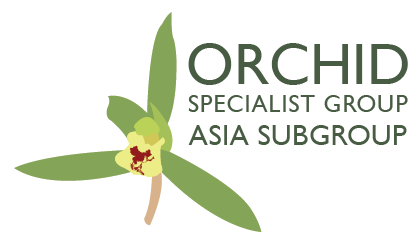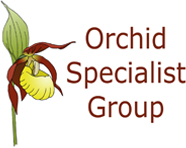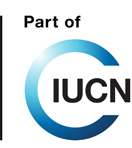Denmark's first ambassador to Thailand, the late Gunnar Seidenfaden, played a unique role in the exploration of the Thai orchid flora. His and Tem Smitinand's pioneering work, The Orchids of Thailand: A Preliminary List (Seidenfaden & Smitinand 1959-1965), marked the beginning of serious documentation of the Thai orchid flora, enumerating 771 identified and 87 unidentified species. Thereafter, Seidenfaden's magnum opus, Orchid Genera in Thailand (Seidenfaden 1975–1980, 1982–1988), raised the number of known species to ca. 1200. The highly improved knowledge of the identity, distribution and frequency of individual orchid species in Thailand created the essential basis for a reasonably complete and sound treatment of the Orchidaceae in the first national Thai red list (Santisuk et al. 2006). In 1967, the multilateral Flora of Thailand project was launched (Larsen 1979), and preparation of an Orchidaceae account for this series would enable an expanded and updated knowledge for future revision of the red list.
Around 1959, Seidenfaden donated his magnificent living collection of wild-collected Thai orchids to the Copenhagen Botanical Garden, now part of the Natural History Museum of Denmark (NHMD), and he later bequeathed his comprehensive holdings of spirit samples, colour slides, line drawings, working files, orchid publications and scientific correspondence to the Botanical Museum and Library (Herbarium C, now part of the NHMD). Seidenfaden passed away in 2001, and later the same year the Flora of Thailand editors invited me (then curator at Herbarium C) to coordinate the preparation of the Orchidaceae account for the Flora. I gratefully accepted and initiated development of the orchid account in 2002. Since I left my position at the NHMD in 2017, my contribution has been organised as a consulting assignment for Aarhus University.
Organising the Seidenfaden material
The first few years were spent on basic preparations. Firstly, we hired a couple of students to scan all the line drawings and colour slides inherited from Seidenfaden. Secondly, the Botanical Museum and Library entered a general copyright agreement with the photographer and the three artists who originally prepared the illustrations, ensuring that an unlimited number of these could be reproduced in the Flora of Thailand free of charge. Thirdly, a database for Seidenfaden's material was developed, and in the following years, digital registration of the numerous spirit samples, colour slides and line drawings was completed (mainly by Katja Anker, Seidenfaden's former assistant). In 2010, the Seidenfaden Database of Orchids went online via the website of the NHMD (Pedersen 2010), and this has proven immensely useful for authors contributing to the Flora of Thailand orchid account.
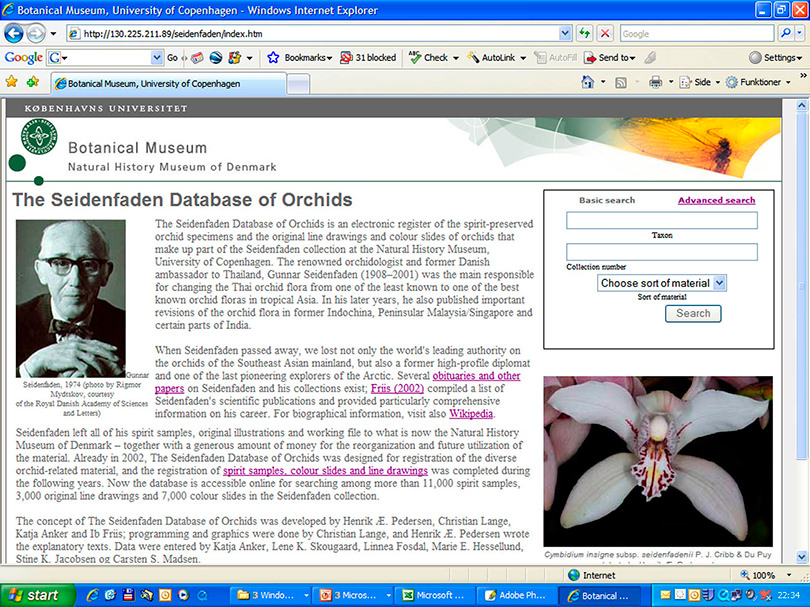
Structuring the orchid volume
Naturally, the orchid account should adhere to the general style of the Flora of Thailand as a whole – for example, by presenting genera and species in alphabetical order. However, I also found it crucial that every instalment should be fully functional from the moment it was published. I eventually proposed that the Orchidaceae should make up one volume published as six instalments, each covering one or more well-defined systematic groups and providing a key to the genera included. Furthermore, the first instalment should contain an entrance key to the overall systematic groups, hence guiding the user to the relevant instalment. The editors accepted my proposal and reserved volume 12 for the orchid account. It should be noted that the Apostasioideae were not part of the plan, as this taxon had been treated previously as family Apostasiaceae in the Flora of Thailand (Larsen & de Vogel 1972).
Organisation, workflow and status
Three categories of people contribute directly to developing the orchid volume: the authors, the coordinator and members of the editorial team. Whereas the coordinator has broad interaction with both authors and editors, the latter two groups do not interact directly.
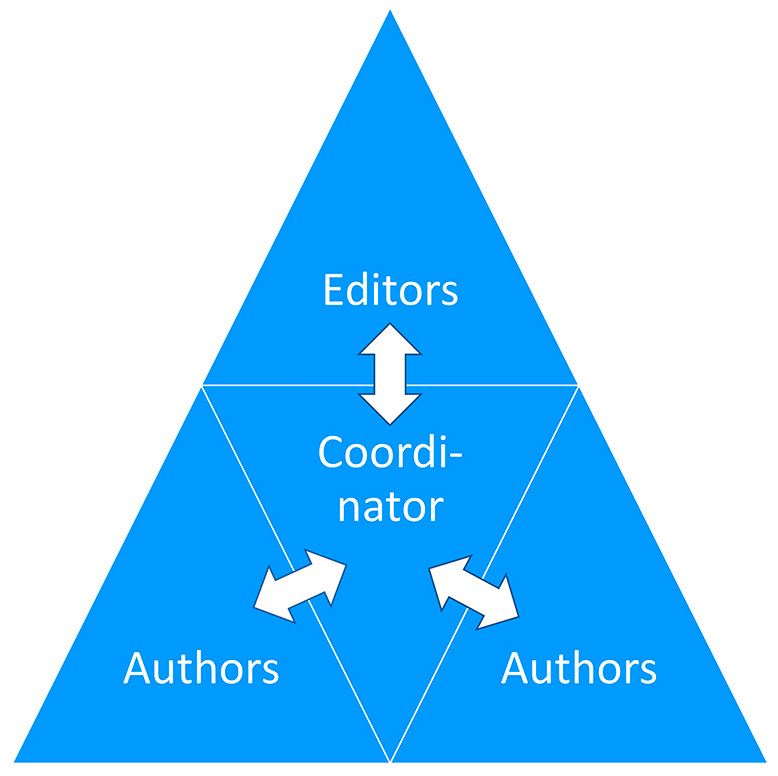
This very simple organisation greatly helps me, as coordinator, to monitor progress and to adjust contributions and activities. Preparation of each individual instalment has the following workflow:
- I invite a selection of authors who must individually accept the predetermined deadline before the agreement is confirmed.
- Using a set of detailed author guidelines developed specifically for the orchid account, each author prepares his or her contributions and submits them to me.
- I pre-edit each individual contribution by correcting any erroneous formatting and any terminology deviating from the prescribed standard. When returning the text to the author for control, I also will pinpoint any obvious scientific problems or mistakes in need of attention.
- Each author submits an adjusted version of his or her contributions.
- I assemble the adjusted contributions into a combined manuscript. This also includes the generic key and other introductory parts that I have prepared in parallel with steps 1–4, consulting the authors along the way. The combined manuscript is then submitted to the editors-in-chief.
- A scientific peer review is performed by a referee invited by the editors-in-chief.
- I lead the revision, involving the individual authors wherever relevant, and submit the revised manuscript to the editors-in-chief.
- Following formal acceptance of the revised manuscript, the technical manager prepares the layout and generates proofs.
- At least one editor-in-chief and I carefully read and correct the proofs – in as many rounds needed to reach a satisfactory result.
- The editors-in-chief approve the final version and ask the printing office to produce the book.
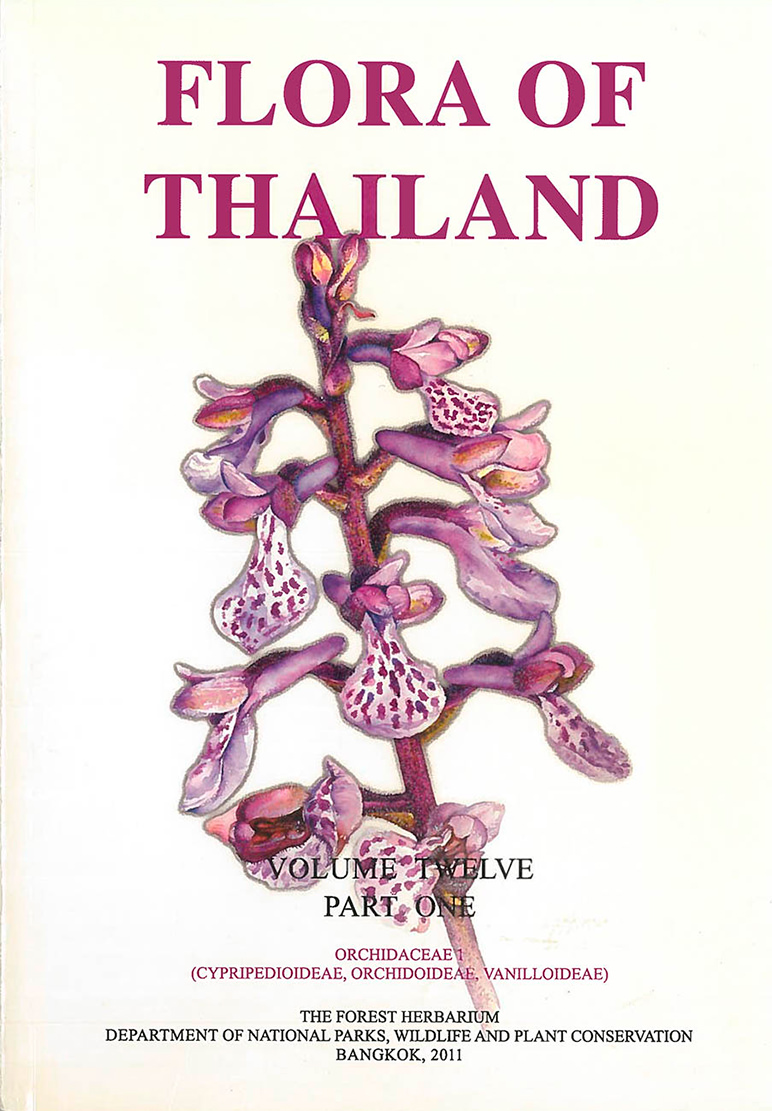
Following nine years of basic preparations, process development and manuscript writing/editing, the first instalment was published in 2011 (Pedersen et al. 2011). Whereas the second instalment followed just three years later (Pedersen et al. 2014), the third instalment (Pedersen et al. 2022) suffered significant delay and the underlying reasons deserve to be outlined.
Genus-level challenges to publication of the third instalment
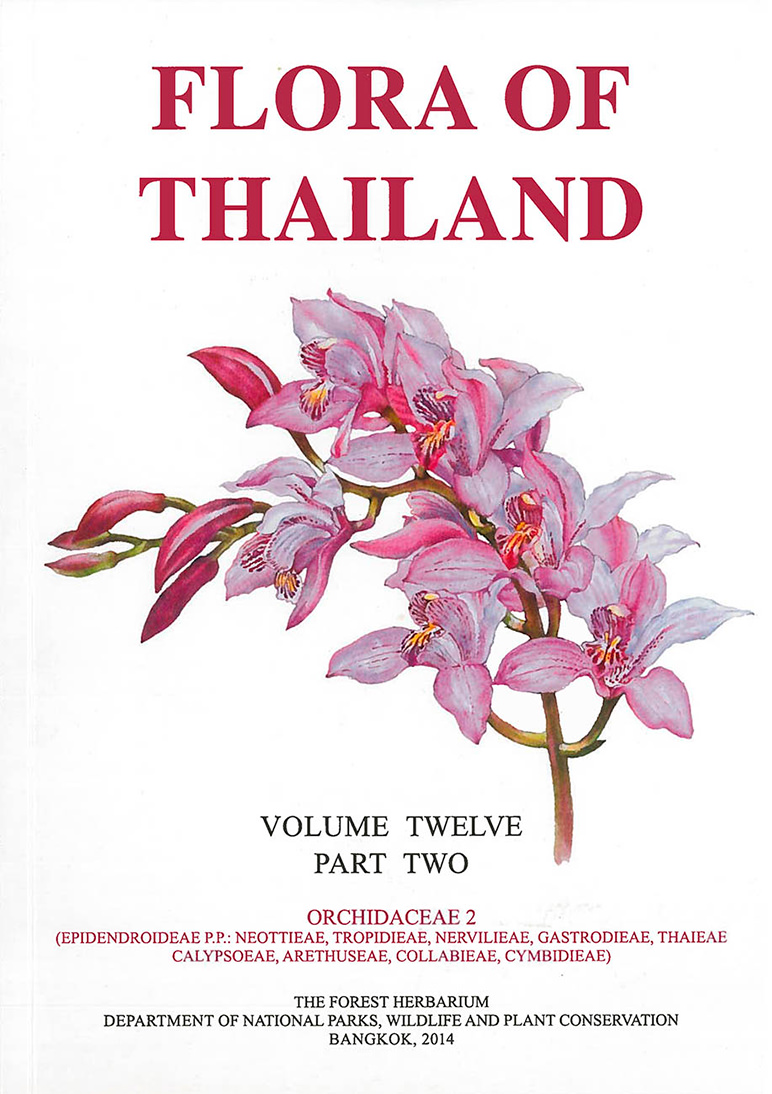
In essence, the Flora of Thailand orchid volume represents a revision of Orchid Genera in Thailand (OGT; Seidenfaden 1975–1980, 1982–1988), with the addition of full descriptions and ecological information. The third instalment was planned to cover tribes Malaxideae and Podochileae, of which 13 genera are recognised in OGT. It was hardly surprising, then, that the four taxa presenting the greatest challenge to us were Seidenfaden's most species-rich genera of Malaxideae/Podochileae in Thailand: Liparis (30 species), Malaxis (22), Oberonia (33) and Eria (63).
In the Flora of Thailand, orchid genera normally are delimited according to Genera Orchidacearum (GO; Pridgeon et al. 1999–2014). However, we have kept the option open to occasionally delimit genera differently, should the GO classification appear problematic. In GO, the generic classification of the Malaxideae and Podochileae is largely congruent with OGT, with the following important exceptions:
- Liparis sect. Distichae is raised to generic rank under the name Stichorkis.
- Malaxis is divided into a few distinct genera – of which Crepidium, Dienia and Oberonioides include species occurring in Thailand.
- Eria, as circumscribed in OGT, is split into several genera, most of which include species occurring in Thailand.
- Oxystophyllum, for many years commonly treated as a Dendrobium section, is reinstated as a distinct genus under subtribe Eriinae.
Given that the GO changes to Malaxideae are largely considered uncontroversial, we adopted them directly for the Flora of Thailand treatment. In contrast, I found it difficult to accept GO's reclassification of Eria s.l. The polyphyly of Eria s.l. and the need for reclassification was evident, but several of the newly recognized genera exhibited such broad morphological overlap that it would compromise their treatment in the Flora. Thus, our main taxonomic challenges turned out to be at the genus level for Eria s.l. and at the species level for the three larger genera in Malaxideae.
GO's reclassification of the Eriinae largely relied on DNA-based phylogenetic studies from the Ph.D. project of Ng Yan Peng. Fortunately, both she and her supervisors agreed to join forces with André Schuiteman, Santi Watthana and my own team in Copenhagen to develop a new classification based on an expanded phylogenetic analysis with broader taxon sampling and the addition of an extra plastid region. In the resulting paper (Ng et al. 2018), we followed GO in splitting Eria s.l., but the genera we ended up recognising (and/or their circumscription) differed.
Species-level challenges in the third instalment
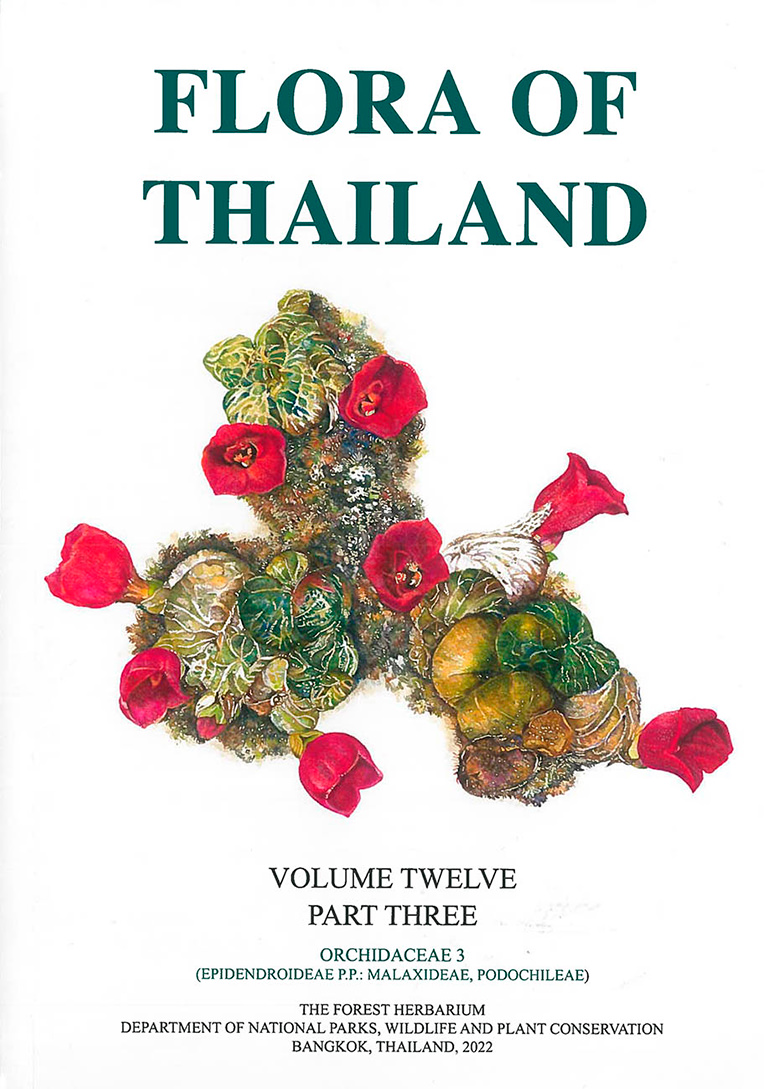
Our main species-level challenges were concerned with Liparis, Oberonia and Crepidium. In each case, the genus, its taxonomy and composite variation (with a special focus on Thailand) became the subject of a PhD study. Thus, Naiyana Tetsana studied Liparis, Kanok-on Bunpha studied Oberonia, and Anchalee Nuammee studied Crepidium. This arrangement secured sufficient time and resources for all activities needed for a thorough revision – ranging from extensive literature studies to field work and visits to all relevant herbaria.
The projects on Liparis and Oberonia were designed in such a way that all findings would be published in peer-reviewed journals. This also applied to a full taxonomic revision of either genus in Thailand (Bunpha et al. 2019; Tetsana et al. 2019). In other words, preparation of a Flora contribution was not in itself the prime objective of either PhD project, but a spin-off outcome. From a scientific point of view, the initial preparation of revisions for a peer-reviewed journal had at least four advantages:
- Complete synonymies could be presented no matter the number of synonyms.
- All type specimens could be cited properly.
- The morphological descriptions could be as long and elaborate as desired.
- All taxonomic and nomenclatural problems could be discussed in depth.
However, from a specific Flora of Thailand point of view, the same model also had significant disadvantages:
- Preparation of the Flora account was delayed because it had to await publication of the journal article.
- Very different formatting requirements between the journal and the flora greatly increased the delay.
- The copyright stipulations of the journal, combined with funding limitations, meant that all species had to be illustrated twice.
Mainly to avoid these drawbacks, the PhD project on Crepidium was designed to integrate preparation of the flora account, whereas no separate revision was planned. This implied a virtually contrasting set of advantages and disadvantages.
Lessons learned
The in-depth studies on Eriinae, Liparis, Oberonia and Crepidium improved the quality of the associated Flora contributions. At the same time, they all delayed production of the third instalment, although the Crepidium model caused less delay than the Liparis/Oberonia model. Accordingly, we adopted the following principles (as recommendations) to achieve a more appropriate balance between quality and publication speed for the remaining instalments:
- Engagement in generic reclassification should be avoided unless absolutely necessary.
- In-depth studies at the species level are encouraged.
- Separate publication of a full revision prior to the preparation of a flora account should be avoided.
We are trying to apply the lessons learned during our preparation of the remaining instalments (parts 4–6), which are all scheduled to be completed prior to the officially announced end of the Flora of Thailand project by 31 December 2024. We are doing our best to make this happen.
Prospects
Taxonomic and distributional surveys of national floras always represent a point in time and can never be perfect. Species disperse, populations disappear, field exploration reveals previously overlooked occurrences, and new species are recognised while others are rejected as being taxonomically unwarranted. (Pedersen et al. 2018). Ten years ago, I published a comparison between the Flora of Thailand account on subfamily Orchidoideae and two previous revisions of this subfamily in Thailand (Pedersen 2013). My comparison amply demonstrated the usefulness of revising the Thai orchid flora repeatedly. Thus, the three revisions conducted within half a century of one another exhibited a progressive increase in the net number of taxa accepted, and the total number of changes was even higher, as additions and exclusions partly neutralised each other.
In conclusion, the Flora of Thailand orchid account looks set to represent a significantly increased level of knowledge. This can – and should – be utilised for improving conservation priorities primarily through revised editions of the Thai national red list. The latter process already has started, as the first two instalments of the orchid account were available prior to the preparation of Threatened Plants in Thailand (Chamchumroon et al. 2017).
Further reading
Bunpha, K., Sridith, K. & Pedersen, H. Æ. 2019. A taxonomic revision of Oberonia (Orchidaceae: Epidendroideae: Malaxideae) in Thailand. Phytotaxa 420: 102–156.
Chamchumroon, V., Suphuntee, N., Tetsana, N., Poopath, M. & Tanikkool, S. 2017. Threatened Plants in Thailand. Department of National Parks, Wildlife and Plant Conservation; Bangkok.
Larsen, K. 1979. Exploration of the Flora of Thailand. In: Larsen, K. & Holm-Nielsen, L. B. (eds.), Tropical Botany. Academic Press, London, pp. 125–133.
Larsen, K. & de Vogel, E. F. 1972. Apostasiaceae. In: Smitinand, T. & Larsen, K. (eds.), Flora of Thailand 2(2). Applied Scientific Research Corporation of Thailand, Bangkok, pp. 131–138.
Ng, Y. P., Schuiteman, A., Pedersen, H. Æ., Petersen, G., Watthana, S., Seberg, O., Pridgeon, A. M., Cribb, P. J. & Chase, M. W. 2018: Phylogenetics and systematics of Eria and related genera (Orchidaceae: Podochileae). Botanical Journal of the Linnean Society 186: 179–201.
Pedersen, H. Æ. 2010. The Seidenfaden Database of Orchids: a new online facility for research on tropical Asian Orchidaceae. Orchid Research Newsletter 56: 5–7.
Pedersen, H. Æ. 2013. Is it really worthwhile revising the same flora repeatedly? A case study in Thai Orchidaceae. Thai Forest Bulletin (Botany) 41: 145–156.
Pedersen, H. Æ., Kurzweil, H., Suddee, S. & Cribb, P. J. 2011. Orchidaceae 1 (Cypripedioideae, Orchidoideae, Vanilloideae). In: Santisuk, T. & Larsen, K. (eds.), Flora of Thailand 12(1). The Forest Herbarium; Department of National Parks, Wildlife and Plant Conservation; Bangkok, pp. 1–302, Pls. I–XXIV.
Pedersen, H. Æ., Kurzweil, H., Suddee, S., de Vogel, E. F., Cribb, P. J., Chantanaorrapint, S., Watthana, S., Gale, S. W., Seelanan, T. & Suwanphakdee, C. 2014. Orchidaceae 2 (Epidendroideae p.p.: Neottieae, Tropidieae, Nervilieae, Gastrodieae, Thaieae, Calypsoeae, Arethuseae, Collabieae, Cymbidieae). In: Santisuk, T. & Balslev, H. (eds.), Flora of Thailand 12(2). The Forest Herbarium; Department of National Parks, Wildlife and Plant Conservation; Bangkok, pp. 303–670, Pls. XXV–LVI.
Pedersen, H. Æ., Find, J. I., Petersen, G. & Seberg, O. 2018. On the "Seidenfaden collection" and the multiple roles botanical gardens can play in orchid conservation. Lankesteriana 18: 1–12.
Pedersen, H. Æ., Bunpha, K., Tetsana, N., Chantanaorrapint, S., Traiperm, P., Nuammee, A., Watthana, S., Suddee, S. Gale, S. W., Seelanan, T. & Rattanakrajang, P. 2022. Orchidaceae 3 (Epidendroideae p.p.: Malaxideae, Podochileae). In: Chayamarit, K. & Balslev, H. (eds.), Flora of Thailand 12(3). The Forest Herbarium; Department of National Parks, Wildlife and Plant Conservation; Bangkok, pp. 671–1015, Pls. LVII–LXXXVIII.
Pridgeon, A. M., Cribb, P. J., Chase, M. W. & Rasmussen, F. N. (eds.) 1999–2014. Genera Orchidacearum 1–6. Oxford University Press, Oxford.
Santisuk, T., Chayamarit, K., Pooma, R. & Suddee, S. 2006. Thailand Red Data: Plants. Office of Natural Resources and Environmental Policy and Planning, Bangkok.
Seidenfaden, G. 1975–1980. Orchid genera in Thailand I–IX. Dansk Botanisk Arkiv 29(2): 1–50; 29(3): 1–80; 29(4): 1–94; 31(1): 1–105; 31(3): 1–149; 32(2): 1–195; 33(1): 1–94; 33(3): 1–228 & 12 pls.; 34(1): 1–104.
Seidenfaden, G. 1982–1988. Orchid genera in Thailand X–XIV. Opera Botanica 62: 1–157; 72: 1–124; 83: 1–295; 89: 1–216; 95: 1–398.
Seidenfaden, G. & Smitinand, T. 1959–1965. The Orchids of Thailand: A Preliminary List. The Siam Society, Bangkok.
Tetsana, N., Sridith, K., Watthana, S. & Pedersen, H. Æ. 2019. A taxonomic revision of Liparis (Orchidaceae: Epidendroideae: Malaxideae) in Thailand. Phytotaxa 421: 1–65.
Henrik Pedersen is the Director and Owner of Select Nature Denmark, and a Thailand Country Representative for the IUCN SSC Orchid Specialist Group-Asia.
